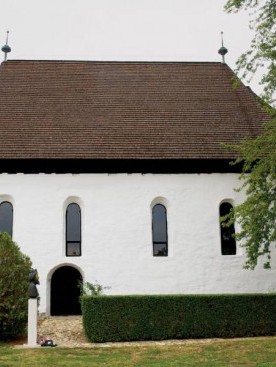The Calvinist Church – SzabolcsThe Hungarian tribes arriving in the CarpathianBasin settled first in this area and chose as the seat of their chieftain the settlement Szabolcs. They built a fortress here using huge logs for erecting its walls. They made wooden compartments with these logs and filled the compartments with earth. The fortress made of earth in Szabolcs is one of the most impressive and largest fortresses of its kind in Central Europe. During the middle ages, Szabolcs with its massive fortress was the seat of Szabolcs county, too. Moreover, the Calvinist church in Szabolcs is one of the oldest centres of worship in the whole county. The church stood already in the 11th century. The town of Szabolcs hosted on the 20th of May 1092 the synod and the legislative diet attended by king Saint Ladislaus. During this period of time, the church of Szabolcs was the place of worship where the dean of Szabolcs held sermons. The church was dedicated to The Holy Mary. The building of this church started by the end of the 11th century. Then, the church’s layout was that of a basilica consisting of a nave and two aisles. It was built of stone and the aisles also contained altars. The sanctuary was covered by a vault made of stone and had a semi-circular base, while the vaulted aisles ended in straight lines. The entrance was on the southern side and the exterior walls were covered by plaster containing lime. The church dedicated to The Holy Mary became a parish church at the beginning of the 15th century. This is the time when the sacristy was added, too. According to various written accounts, the sanctuary was decorated with frescoes representing apostles and saints. Unfortunately, the remains of these murals can hardly be interpreted. Later, the church almost fell into ruin. In 1757, the six stone buttresses still existed and were supporting the vault. These had to be covered with plaster again. In the meantime, the southern entrance was made larger. The stone buttresses became fissured during an earthquake in 1847 and were tore down. The southern entrance was walled up, another one was cut on the western frontispiece and the sacristy was torn down. In 1900, another major rebuild followed. A new entrance was cut instead of the western gate. This new entrance was opened through the semi-circular wall of the sanctuary. The builders also attached a 40 metres high bell-tower to the western side of the church, but the retreating German troops blew the tower up at the end of 1944. The explosion destroyed parts of the western wall, too. After the war, the missing parts of the wall were reconstructed. The archaeological excavations, which commenced in 1970, revealed the stone buttresses. The work was continued later and, as a result, a textbook example of restoration was performed. In consequence, the church offers the authentic feeling of a medieval space. The Holy Mary monastery in Szabolcs, where the sanctuary having a single apse is connected to a basilica-like space composed of three naves is the archetype of the 11th century Hungarian church architecture. The floor plan of this church is similar to the ones characterising the original cathedral in Kalocsa, the chapel in Pécsvárad and the church of the royal mansion in Zirc. The church in Szabolcs is the gateway to the Route of Medieval Churches and also one of the most beautiful historical buildings in Szabolcs county. |























